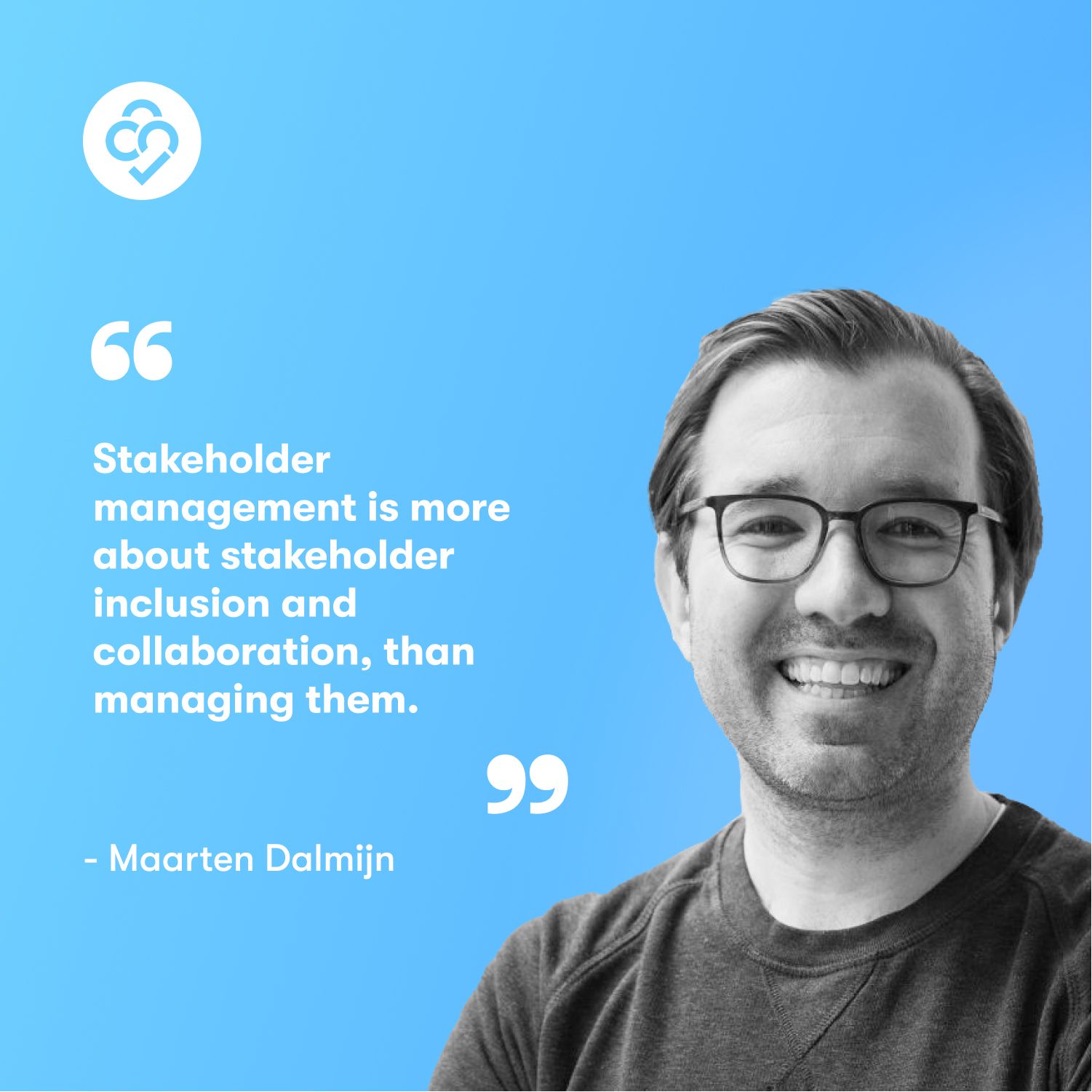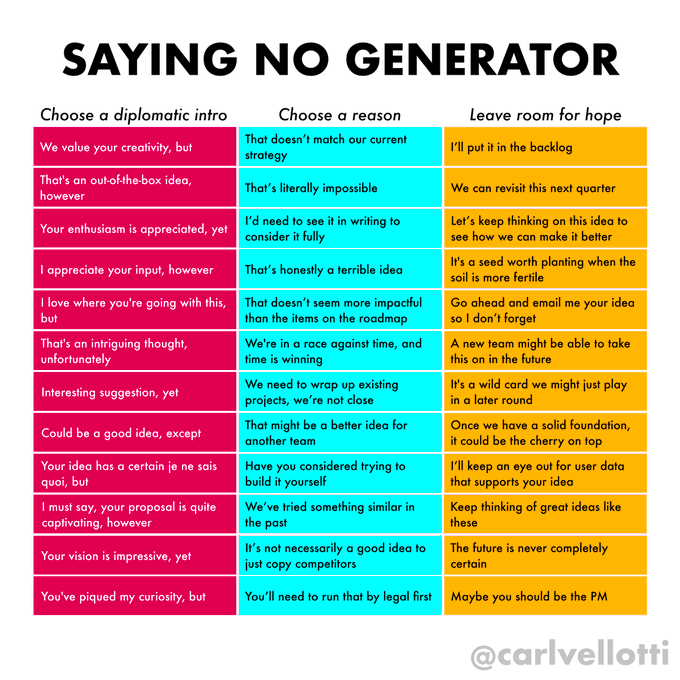How to Say No as a Product Manager

17 ways to say no, from the experts
Being a product manager is no easy task. It requires a delicate balance of leadership, strategic thinking, and the ability to navigate complex situations. One of the most challenging aspects of the role is learning how to say no effectively. Whether it's resisting feature creep, managing limited resources, or navigating competing priorities, saying no is a crucial skill that can make or break the success of a product.
As a product manager, there will be countless moments when you have to decline requests, manage expectations, and make tough decisions that may not align with everyone's desires. In this article, we've compiled real-life insights from top product leaders who have gracefully mastered the art of saying no.
Without further ado, here are 17 ways to say no as a product manager, without jeopardizing relationships or derailing projects:

x
1. If you play the game right, you'll never need to say no
The notion of saying "no" is a myth propagated by experts. As a product manager, you seldom outright reject a proposition.
Think of it as a game of chess where turns are taken to play. When someone makes a request, consider it the start of a chess game. The proposer might want an immediate checkmate, but that's not how it works.
Your move is to delve deeper by asking clarifying questions about the proposition's value. Treat the proposer as another product manager, albeit one with less experience that you're training. As you get better at this, you'll become more proficient at identifying weak spots and prompting them to gather more information. Even better, you'll either be able to 'checkmate' them, or they will unwittingly do so themselves. Therefore, you never really need to say "no."
Remember, most people are just guessing and trying their best to make it work. Life can be compared to a giant casino where the most confident or eloquent player often wins. Stay grounded in your role as a product manager and invite them to play the game.
As a PM, remember - you're the house, and the house never loses.
- Phil Araujo, writer of The Product Heroes Newsletter
x
2. Shift from Yes/No to active listening
I'm a PM with ADHD. Anxiety is a constant enemy of mine. Here's a framework I've found helpful.
- Reframing responses from a binary yes and no to active listening. Anxiety makes you want to think your only options are to succeed( yes)or fail (no). In reality, being a major portion of being a PM is not just solving the problem but understanding the scope of it. This requires being able to listen and have your stakeholders feel heard. They might not know what they really want yet. Use their question as a chance to learn more about their needs instead purely yes/no.
- Try using yes, no, "or better" as a default outcome in your brain. “Or better” represents the unknown state that could be even better than the question or the goal at hand. A PM's job is to find that "or better" state ideally.
- Asking a version of 5 whys can you and the person navigate to what the true underlying needs are. It also helps slow down the conversation and relax your anxiety by allowing you time to process what's going on.
- Rawi Nanakul, writer of Tech Atypically, an ADHD and Product Management newsletter
x
3. Be empathetic and provide context
There’s a crappy way of saying no and literally shutting down conversations, and there’s a more friendly and open way of saying no, while still keeping your boundaries and protecting your sanity.
The important thing to remember here is not everyone has the same context you do.
The mark of a good leader is the ability to repeat yourself often, in different ways, through different formats. It isn’t easy to switch context and tune into a new conversation — even more so when you’re presenting a powerpoint. You cannot expect your team to remember what your vision is because you talked about it once! Reference it as much as possible, that’s how you’ll be able to drive the message home.
- Andrea Saez, Product Consultant and Writer (read her full article here)
x
x
4. Include stakeholders in setting boundaries
Set those boundaries together. Don’t create boundaries and throw them over the fence to be enforced with your stakeholders.
Your stakeholders often want different things, way too many things, and they want them faster than you’re capable of delivering them. This means you have to make trade-offs.
Either you make them a victim of trade-offs happening to them, or you make them one of the perpetrators by including them. Stakeholder management is more about stakeholder inclusion and collaboration, than managing them.
- Maarten Dalmijn, author of Driving Value with Sprint Goals

x
5. Help them understand the product vision
Bring it back to the shared mission and objectives. Help them understand it’s not “no,” but “this is better instead.”
- Aakash Gupta, VP of Product at Apollo
x
6. Keep your team focused
As a PM, you must deliver impact on business metrics by keeping your team's focus while navigating company politics. To achieve this, you need to say no frequently—the best way to base it on objective criteria.
Focus on the priorities of the team ("This is a great idea for referral, but we focus on onboarding"), on metrics ("This feature reaches fewer target customers than the other one"), or refer to a point in the future when you get back to the idea ("We will focus on this next quarter"). This way, the conversation will be about the decision criteria rather than the concept itself.
- Andrea Sipos, Product Coach
x
7. Let the data speak for itself
On saying “no” - I do the typical things like determine the goal, gather data, qualitative feedback, and get cross functional feedback.
Then I put it in a pre-read and determine a narrative around it.
The thing that works the best is to let the information speak, particularly user feedback, vs making it seem like it’s a personal opinion.
Oftentimes it’s tempting to challenge the assumptions/ROI in the moment, but be prepared for it to backfire.
- Nicole Daines, Product Leadership and Management
x
8. Provide clarity and context
The best product managers don't actually say 'no' a lot. Instead, they provide clarity and context so that stakeholders can say ‘no’ to themselves.
For example, instead of saying 'no' ask:
- Can you explain how this fits within our current strategy? (and if not, can you help me understand why our strategy should change?)
- Can you help me understand how this helps us achieve our current goal/outcome?
- Great idea, can you share with me the supporting data on this problem space?
You can also remind them of the current goals/problems/priorities, etc.
- Great idea, but remember that our current strategy is....
- Thanks for the suggestion, but I'd like to remind you that our current goal is...
- Thanks but the team is currently focused on...
Which is why, one of the highest-leverage activities you can do as a Product Manager is to cultivate a shared understanding of your current product vision, strategy, goals, and priorities. And if you do feel as though you constantly need to say 'no', then perhaps that is a signal to revisit your strategy, vision, goals, and priorities and how well (or not so well) are they being communicated.
- Ant Murphy, Founder of Product Pathways
x
9. Save it for later
Saying no is an art form. It's not about refusal, but about prioritization. My favorite line is, 'That's a fantastic thought for our next version. For now, we need to nail what we've committed to.'
- Carl Vellotti, author of the Futureproof PM newsletter

10. No --> Tell me more
We have fundamentally misunderstood what saying ‘no’ as a PM actually means. For starters, saying ‘no’ should never be your default.
We’ve been taught to so ruthlessly protect our time and our team’s focus, we often jump to ‘no’ when really we should be saying ‘tell me more’. As any good PM will tell you, discovery is paramount, so it’s your job to make sure you fully understand what you might be saying no to. Remember: You don’t have all the answers - be open to the possibility that others have new information that could lead you to reprioritize!
And if that’s not the case, you must ensure that people understand why you’re saying no to them. There’s nothing more frustrating than not getting to work on something you feel is really important - and guess what, your stakeholders feel the same! So help them understand how you prioritize and what you’re prioritizing against by saying ‘no, because…’ or ‘not right now’ instead of just ‘no’. Once people become aware of the trade-offs they are more likely to become allies rather than detractors.
- Antonia Landi, PM Consultant & Coach
x
11. Get people to stop asking questions
“Just say no!” cries the B2C product manager, whilst the B2B product manager buries their head in their hands for the 6th time this week. On the one hand, saying “no” is essential. You can’t do everything for everyone. On the other hand, when faced with the irresistible force of a sales-led organisation trying to close a deal worth 20% of your ARR, “just say no” doesn’t cut it.
You can’t just say no unless you have a strategy. Don’t have one? Make one! And remember, better than saying “no” is to get people to never ask the question in the first place. You can achieve this through alignment and building trusting, long-lived relationships with your sales team. You’ll never eliminate the questions, but you should be able to reduce them to manageable levels.
- Jason Knight - B2B product management consultant and podcaster
x
12. Use evidence to back up your choices
One of the biggest obstacles to making evidence-informed decisions about what opportunities to pursue and which not is the need for objective decision-making criteria. Depending on the size of your company and the lifecycle of your product, these could come in the form of a tangible Product Strategy or Outcome-oriented OKRs rooted in proven user problems. Two questions can help product teams to shift the conversation from arguing about delivery to the reasonability of an idea:
1. Would this help us influence our current strategic choices? Ideally, these appear in the form of a proxy metric beyond statements.
2. What's the evidence that this idea addresses a customer problem worth solving, or how the riskiest assumptions behind it are valid?
The answer to these questions should either lead to revisiting your current strategic choices or investing in a better understanding of the problem and solution space through research and testing.
- Tim Herbig, Product Management Coach & Consultant
x
13. Foster collaboration and trust
Maintaining positive stakeholder relationships while delivering negative news is crucial for fostering collaboration and trust. Here are some key approaches that me and my team follows:
a. Active Listening: We give stakeholders the opportunity to express their perspectives and concerns. By actively listening and demonstrating empathy, we show that their input is valued.
b. Transparent Communication: We communicate the rationale behind our decisions openly, explaining the factors considered and how they align with the company's objectives. Transparency builds trust and helps stakeholders understand the bigger picture.
c. Alternative Solutions: When saying "no," we strive to provide alternative solutions or suggestions that may address the underlying needs or concerns. This shows our commitment to finding mutually beneficial outcomes.
d. Continuous Engagement: We maintain an ongoing dialogue with stakeholders, even after delivering negative news. By staying engaged and demonstrating our dedication to their success, we foster positive relationships and remain open to future collaboration.
- Diana Soler, Product Operations Leader & Mentor
x
14. Come armed with intel
The art of saying no is a muscle that requires exercising in every product manager's repertoire.
You need to spend as much time as possible becoming an unrivaled expert in all the details relating to your product, markets, segments, gaps/capabilities, and your competitive landscape. If you have all this intel, when it comes to saying no to a request, you are much better equipped in doing so with rationale.
Transparency is of utmost importance, this comes with regularly presenting your roadmap, creating buy-in, and influencing with sound rationale.
- Pooja Naidu, Senior Product Director at Mews
x
15. Saying no in 6 steps
1. Set goals and evaluate requests accordingly. Your Objectives and Key Results (OKRs) can be helpful here.
2. Be transparent and honest about your team's workload, capacity, and conflicting priorities.
3. Explain your decision with assertiveness and confidence, using clear language. If you have data, use it.
4. If possible, offer alternative solutions.
5. Establish credibility and prevent exploitation by staying firm and consistent in your decisions.
6. To build confidence, start by saying no in low-stakes situations. Like any skill, you can improve with practice.
- Jenny Herald, VP of Product Evangelism and host of Dreams with Deadlines
x
16. Understand both sides
Build a good relationship with your stakeholders - More often than not the act of saying NO is painful for both the giver and receiver because it is perceived as purely transactional. For the giver, it’s saying NO to a pesky ask. For the receiver, it’s being blocked.
But when there is a good relationship between two sides, there’s a better understanding of each other’s goals, context, process, and even capacity. This can make saying NO just a natural part of your collaboration with your stakeholder.
- Kax Uson, Head of Product and coach for Women in Product
x
17. Describe your decision-making process
To ensure focus, alignment with the product strategy as well as the optimal use of capacity (e.g., design, engineers) you often need to say no to requests. Given the diverse stakeholder landscape, this task is not easy.
The method that works best for me is describing my decision-making and thought process so that others understand the underlying reasons. When explaining, support your arguments with different ingredients such as:
- Product data (e.g., data analy7cs)
- Social proof (e.g., feedback from engineers)
- Research data (e.g., product discovery results)
By using this strategy, you can confidently say no while nurturing stakeholder relationships.
- Denny Klisch, Director Platform Product Management
x
Tl;dr
Being a product manager means understanding the bigger picture, making tough decisions, and steering the product toward success.
By implementing these expert insights and strategies, we can confidently navigate feature creep, resource constraints, unrealistic timelines, and other hurdles that come our way. Remember, saying no is not about being negative—it's about making strategic choices that will benefit the product and its stakeholders in the long run. So, embrace the power of no, and let it guide you to become a more effective and respected product manager.




